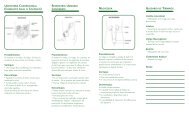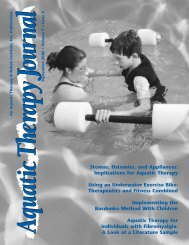Continent Diversion - United Ostomy Associations of America
Continent Diversion - United Ostomy Associations of America
Continent Diversion - United Ostomy Associations of America
You also want an ePaper? Increase the reach of your titles
YUMPU automatically turns print PDFs into web optimized ePapers that Google loves.
medicine did help and she managed to fi nish the track<br />
season in her 16th year.<br />
But in the spring <strong>of</strong> that same year, Weatherton’s<br />
problems went from severe diarrhea with blood to<br />
stools that were entirely blood-fi lled. Not wanting to<br />
see more doctors or return to the hospital, she hid her<br />
condition from her mother. When the bleeding wouldn’t<br />
stop, Weatherton became frightened and eventually<br />
told her mom. She was immediately admitted to Boston<br />
Children’s Hospital for what would be a 2 1/2 month<br />
stay. Donna remembers the incredible team <strong>of</strong> doctors.<br />
But even more incredible to Weatherton’s mom was that<br />
throughout the entire ordeal, her daughter never once<br />
said, “why me?”<br />
Weatherton had no idea <strong>of</strong> what she was about to<br />
go through and in hindsight says she was better <strong>of</strong>f. A<br />
new series <strong>of</strong> tests diagnosed her condition as ulcerative<br />
colitis. In addition to receiving four blood transfusions,<br />
Weatherton had to make some major adjustments.<br />
Fortunately she had tremendous support from her family<br />
and from her friends who would bring Weatherton<br />
schoolwork and keep her company. Her mother made<br />
arrangements with the hospital to stay with her daughter<br />
for the entire time she was there.<br />
She remembers all the wheelchair rides her mom<br />
would give her just to pass the time, and Weatherton’s<br />
dad, who was working in Boston then, stopped by the<br />
hospital every night on his way home. Her longtime<br />
boyfriend was also a constant presence during her<br />
recuperation and the two went from hospital room to<br />
Junior Prom even though she was not fully recovered.<br />
Now Weatherton needed to make a decision about<br />
treatment. Doctors <strong>of</strong>fered her two options: drugs with<br />
side effects or surgery. “I had never even broken a bone,<br />
so surgery was a huge step,” she says. Weatherton opted<br />
for drug therapy which consisted <strong>of</strong> ten pills a day and<br />
resulted in tremors. Her hands would shake if she got<br />
excited and she says, “I never felt quite right and I never<br />
had a normal stool.” When she came home from the<br />
hospital, the severe problems resurfaced and it seemed<br />
surgery was unavoidable.<br />
This time when Weatherton reentered the hospital,<br />
it was for a restorative proctocolectomy, also called<br />
a J-Pouch. Normally achieved in a two-stage surgery,<br />
Weatherton would have to go under the knife three<br />
times because she was so ill. The operation involves<br />
removal <strong>of</strong> the entire colon and all, or nearly all, <strong>of</strong> the<br />
rectum but leaving the anal sphincter muscle intact.<br />
What is known as a J-Pouch (because it looks like the<br />
letter “J”) is constructed from 10 to 12 inches <strong>of</strong> the<br />
small intestine as a reservoir for waste and replaces the<br />
function <strong>of</strong> the rectum. The pouch is then connected to<br />
the remaining anal sphincter muscle so that elimination<br />
remains relatively the same.<br />
In Weatherton’s case, the fi rst surgery entailed<br />
removal <strong>of</strong> the whole large intestine. Afterward, wearing<br />
an ileostomy bag for three months was hard, because<br />
she says, “the kids at school did not understand and<br />
I felt embarrassed.” The second surgery involved the<br />
construction <strong>of</strong> the J-Pouch from normal small intestine<br />
which is then sewn or stapled to the anal muscles and a<br />
temporary “loop” ileostomy is created to allow the bowel<br />
to heal and to protect the newly formed J-Pouch.<br />
During her senior year in high school Weatherton<br />
<strong>Continent</strong> <strong>Diversion</strong> New Patient Guide The Phoenix 13








